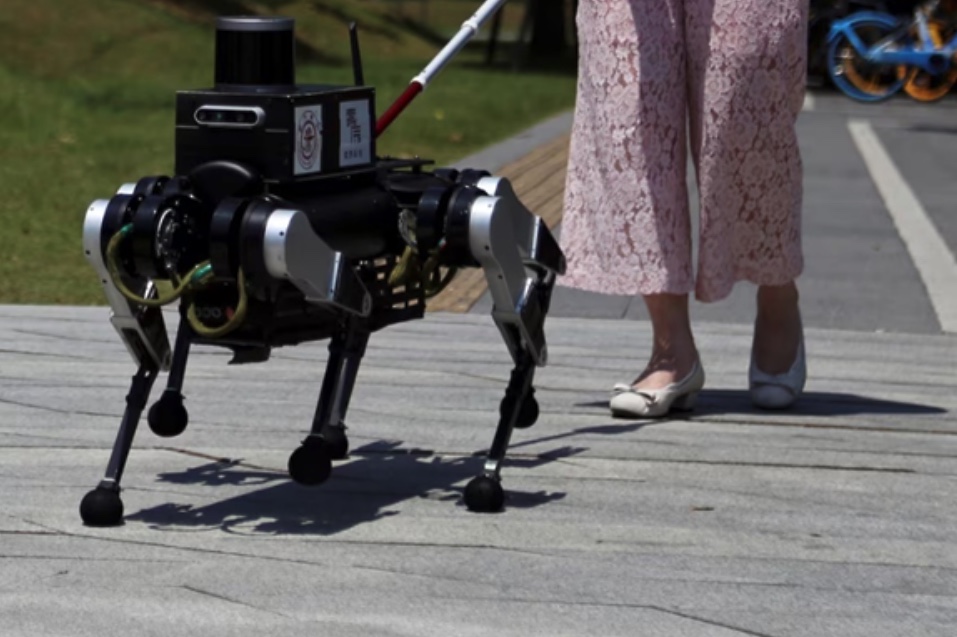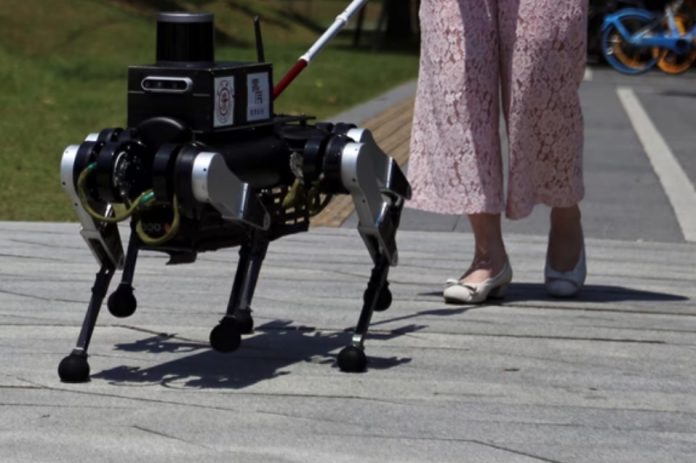ในวันที่ 1 กรกฎาคม 2567 ณ เมืองเซี่ยงไฮ้ สาธารณรัฐประชาชนจีน ทีมนักวิจัยจากมหาวิทยาลัยเจียวทง ในเซี่ยงไฮ้ ได้พัฒนาหุ่นยนต์ “สุนัขนำทาง” 6 ขา เพื่อช่วยเหลือผู้พิการทางสายตา โดยมุ่งหวังว่าจะสามารถเพิ่มความสะดวกในการดำเนินชีวิตประจำวันของผู้พิการทางสายตาได้
โดยหุ่นยนต์ดังกล่าวมีขนาดใกล้เคียงกับสุนัขพันธุ์บูลด็อกของอังกฤษ (English Bulldog) แต่มีความกว้างมากกว่าเล็กน้อย ใช้กล้องและเซ็นเซอร์ในการนำทาง สามารถอ่านสัญญาณไฟจราจรได้ ซึ่งเป็นสิ่งที่สุนัขนำทางทั่วไปไม่สามารถทำได้ นอกจากนี้ยังสามารถสื่อสารด้วยเสียงผ่านระบบปัญญาประดิษฐ์ (AI) และการจดจำเสียง
ศาสตราจารย์เกา เฟิง หัวหน้าทีมวิจัยจากคณะวิศวกรรมศาสตร์เครื่องกล มหาวิทยาลัยเจียวทง กล่าวว่า “การมีขา 6 ขาช่วยให้หุ่นยนต์เคลื่อนที่ได้อย่างราบรื่นและมั่นคงที่สุด เมื่อยกขาขึ้น 3 ขา จะยังเหลือขาอีก 3 ขารองรับน้ำหนัก เหมือนขาตั้งกล้อง ซึ่งเป็นรูปทรงที่มั่นคงที่สุด”
ในปัจจุบัน ทีมวิจัยกำลังทดสอบภาคสนามโดยได้รับความร่วมมือจากคู่สามีภรรยาผู้พิการทางสายตา ลี่ เฟย วัย 41 ปี และ จู ซีบิน วัย 42 ปี โดยลี่ เฟย ซึ่งตาบอดสนิท กล่าวว่า “หากหุ่นยนต์สุนัขนำทางนี้ออกสู่ตลาดและผมสามารถใช้งานได้ อย่างน้อยก็จะช่วยแก้ปัญหาการเดินทางคนเดียวของผมได้บ้าง เช่น การไปทำงาน ไปโรงพยาบาล หรือไปซูเปอร์มาร์เก็ต ซึ่งปัจจุบันผมไม่สามารถออกไปคนเดียวได้ ต้องมีครอบครัวหรืออาสาสมัครไปด้วยเสมอ”
นวัตกรรมนี้แสดงให้เห็นถึงความก้าวหน้าในการประยุกต์ใช้เทคโนโลยีหุ่นยนต์และปัญญาประดิษฐ์เพื่อช่วยเหลือ ผู้พิการทางสายตา ซึ่งอาจเป็นทางเลือกสำหรับผู้ที่ไม่สามารถเลี้ยงสุนัขนำทางจริง ๆ ได้ในอนาคต
โดย รอยเตอร์
China Develops “Robot Guide Dog” to Enhance Quality of Life for the Visually Impaired

On July 1, 2024, in Shanghai, People’s Republic of China, a research team from Jiao Tong University in Shanghai unveiled a six-legged “robot guide dog” designed to assist individuals with visual impairments. The initiative aims to enhance the daily lives of visually impaired persons by increasing their independence.
The robotic device, comparable in size to an English Bulldog but slightly wider, utilizes cameras and sensors for navigation. Notably, it can interpret traffic light signals, a function beyond the scope of traditional guide dogs. The robot communicates verbally through an artificial intelligence (AI) system and voice recognition technology.
Professor Gao Feng, the lead researcher from the School of Mechanical Engineering at Jiao Tong University, elucidated, “The six-legged configuration ensures optimal smoothness and stability in the robot’s movement. When three legs are elevated, the remaining three provide weight support, akin to a camera tripod, offering maximum stability.”
Presently, the research team is conducting field tests with the cooperation of a visually impaired married couple, Li Fei, aged 41, and Zhu Sibin, aged 42. Li Fei, who experiences complete blindness, remarked, “Should this robotic guide dog become commercially available and accessible to me, it would, at minimum, partially address my challenges with independent travel. For instance, it could assist me in journeys to work, hospital visits, or supermarket trips. Currently, I am unable to venture out alone and invariably require accompaniment by family members or volunteers.”
This technological innovation demonstrates significant advancements in the application of robotics and artificial intelligence to assist individuals with visual impairments. It potentially offers an alternative solution for those unable to accommodate a live guide dog in the future.
By Reuters

















